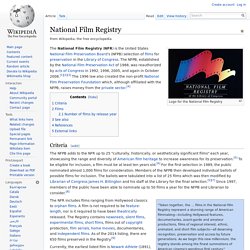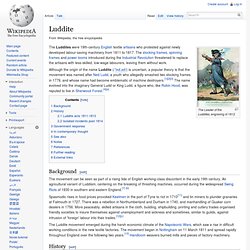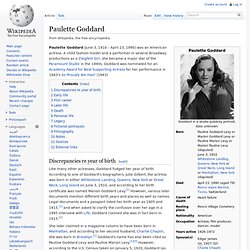

National Film Registry. Logo for the National Film Registry Criteria[edit] The NFPB adds to the NFR up to 25 "culturally, historically, or aesthetically significant films" each year, showcasing the range and diversity of American film heritage to increase awareness for its preservation.[5] To be eligible for inclusion, a film must be at least ten years old.[6] For the first selection in 1989, the public nominated almost 1,000 films for consideration.

Members of the NFPB then developed individual ballots of possible films for inclusion. The ballots were tabulated into a list of 25 films which was then modified by Librarian of Congress James H. Billington and his staff at the Library for the final selection.[5][7] Since 1997, members of the public have been able to nominate up to 50 films a year for the NFPB and Librarian to consider.[8] The NFR includes films ranging from Hollywood classics to orphan films. Films[edit] Number of films by release year[edit] See also[edit] References[edit] External links[edit]
Luddite. The Leader of the Luddites, engraving of 1812 The Luddites were 19th-century English textile artisans who protested against newly developed labour-saving machinery from 1811 to 1817.

The stocking frames, spinning frames and power looms introduced during the Industrial Revolution threatened to replace the artisans with less-skilled, low-wage labourers, leaving them without work. Although the origin of the name Luddite (/ˈlʌd.aɪt/) is uncertain, a popular theory is that the movement was named after Ned Ludd, a youth who allegedly smashed two stocking frames in 1779, and whose name had become emblematic of machine destroyers.[1][2][3] The name evolved into the imaginary General Ludd or King Ludd, a figure who, like Robin Hood, was reputed to live in Sherwood Forest.[4][a] Background[edit] The movement can be seen as part of a rising tide of English working-class discontent in the early 19th century.
History[edit] Luddite acts 1811-1813[edit] Isolated incidents post 1814[edit] Anna puoi sentirmi? Dovunque tu sia... - Il grande dittatore. Paulette Goddard. Paulette Goddard (June 3, 1910 – April 23, 1990) was an American actress.

A child fashion model and a performer in several Broadway productions as a Ziegfeld Girl, she became a major star of the Paramount Studio in the 1940s. Goddard was nominated for an Academy Award for Best Supporting Actress for her performance in 1943's So Proudly We Hail! (1943) Discrepancies re year of birth[edit] She later claimed in a magazine column to have been born in Manhattan, and according to her second husband, Charlie Chaplin, she was born in Brooklyn.[1] Goddard's name has also been cited as Pauline Goddard Levy and Pauline Marion Levy.[1][3] However, according to the U.S. Early life[edit] In response, Levy filed a suit against his daughter, claiming that the interview had ruined his reputation and lost him his job, and demanded financial support from her. Film career[edit] Studio publicity portrait from the 1940s, when Goddard was working for Paramount Pictures. Il Sindaco 5 Stelle Alvise Maniero di Mira (VE) ad Agorà (23.05.2012)
Primarie M5s, i capilista.